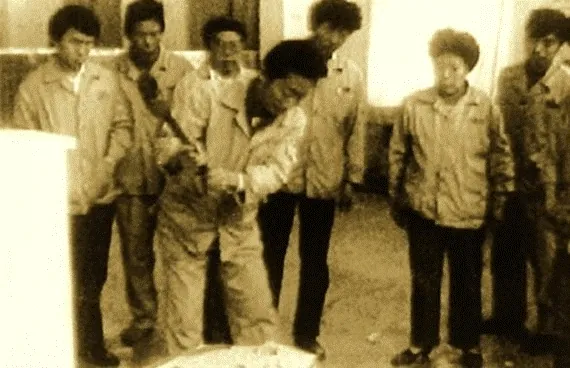Creating an Innovation Ecosystem:
Lessons from Haier
By Daniel Denison (Founding Partner, Denison Consulting)
and William Fischer (Professor Emeritus, IMD Business School)
Lessons from Haier
and William Fischer (Professor Emeritus, IMD Business School)
In just 40 years, Haier has gone from being a regional refrigerator manufacturer in Qingdao, China, to being a global leader in the appliance industry. With over 100,000 employees in over 160 countries, and over $50B in revenues, Haier is one of the market leaders in the global industry. Their 2016 acquisition of GE Appliances also made Haier a major force in the US appliance industry.
Innovation has always been central to Haier’s success and there are many lessons to learn from their approach. Since the very beginning, Haier has been focused on creating a new organizational model designed to drive innovation and transcend the traditional bureaucratic model that has guided industry for over 100 years. Haier has a strong global reputation for innovation and this has driven their growth over the decades.
This article gives an overview of the Haier innovation system. First, we describe their ecosystem structure which supports collaboration among multiple entities, both within Haier and with external partners. Second, we focus on their network of micro-enterprises (MEs), which make up the individual nodes in the ecosystem. This past year, we studied six successful Haier MEs and tried to identify the cultural characteristics that were most closely linked to their success. This article is the first to publish the six-element model created from our research.
We used Denison Consulting’s own culture model and survey assessment in this research and confirmed that these MEs truly had excellent cultures. But the core of this article is the six in-depth case studies that we have researched to develop the six-element framework to characterize the “excellent ecosystem culture” that is a key factor in Haier’s successful track record of innovation.
The Haier Story: From the Beginning
In 1984, Zhang Ruimin took over as director of Qingdao Refrigerator Factory. Dissatisfied with the poor quality of the products, he drew attention to this unacceptable situation by smashing 76 refrigerators with a sledge hammer, as workers looked on in disbelief! This dramatic event also led the rest of the business world to pay attention to Haier’s new commitment to quality.

Figure 1. Smashing poor quality refrigerators at the Qingdao Refrigerator Factory in 1985
(Source: Haier Model Institute)
From this early foundation, Haier has continuously expanded their product lines well beyond their traditional white goods focus into consumer electronics and home appliances. They created sales organizations, production facilities, and design centers all over the world to sustain their growth and innovation. In 2010, they included IOT technology into all of their products, especially in their Smart Homes business, creating products that could communicate and interact with each other. In 2016 they acquired GE Appliances in the USA to create an immediate presence in this important market. GEA had experienced limited growth under GE, but Haier’s strategy focused on growth through innovation. Since the acquisition, GEA’s revenues have doubled (Steiber, 2022).
Haier’s unique approach to growth and innovation has been to organize around ecosystems, made up of micro-enterprises (MEs). MEs are the individual nodes in the ecosystem, both inside and outside of the formal Haier organization. Innovation happens when the network of resources in the ecosystem is organized in pursuit of a customer need. The pull of the market mobilizes the ecosystem. Business leaders, even though they are working within relatively conventional platforms, business units, and industry structures, still understand that these organizational boundaries cannot stand in the way of the value creation process. (Fischer, Lago, & Fang, 2013)
Understanding Haier Culture and Organization
Haier’s culture cannot be understood without acknowledging the central importance of the doctrine of RenDanHeYi as it has evolved over the years. No better way to capture the essence of this philosophy than to use the words of Zhang Ruimin, Founder and Chairman Emeritus of the Board of Directors, Haier Group.
Ren is a Chinese word that means people or person. We mainly use it to refer to employees within an organization. Dan means orders, and here it represents the needs or demand of users. Heyi means integration. So, we’re talking about the fact that everyone, every employee, gets to create value for users. Whatever your value, it is mirrored in the value you create for users. For example, typically an R&D person works without worrying about the final sale [of the product]. But in our model, everyone, including R&D people, must be responsible for the final sale—or lack of sales—of the product they develop. With RenDanHeYi, we’re talking about a virtuous cycle built around creating value for users. (DeSmet, Steele, & Zhang, 2021)

Figure 2. Brief Introduction of RenDanHeYi
(Source: Haier Model Institute)
RenDanHeYi is a philosophy that has evolved to express Haier’s unique approach to doing business by organizing around the value-creation process rather than the control hierarchy. This approach positions user demand in the marketplace as an endless source of creativity and innovation. This outside/in pull orientation is the foundation for Haier’s creativity and growth. It also implies that the value-creation process involves the resources of an entire ecosystem, rather than just resources internal to Haier. The value that is created is shared with everyone who is involved in the process.
Our Study: Defining the Characteristics of an Excellent Ecosystem Culture
During 2023, we studied six microenterprises within Haier. The Microenterprises – MEs – are the building blocks of the Ecosystem and they operate as independent businesses. They exist in different sizes and stages, and they are all entrepreneurial efforts, even though some of them are quite large and operate in mature industries. Along with our partners, the team from the Haier Model Institute (HMI), we selected six excellent MEs to try to understand the culture characteristics that were associated with their success. With over 4000 MEs in Haier, this project was an attempt to identify characteristics that these excellent MEs had in common in order to create a set of guidelines to help guide the other MEs. Here is a brief description of the six MEs that we studied.
- Smart Vaccines. Smart Vaccines started about 10 years ago by supplying the refrigerators used to preserve vaccines in local clinics. They discovered that the number of times that the door was opened per hour dramatically increased the spoilage rate. So, one of their first innovations was a refrigerator with eight doors! This quickly reduced the spoilage rate. From this first innovation, they continued to develop technology to track vaccine quality and availability, and now are an important providers of medical information systems in the national market.
- Smart Energy. The Smart Energy ME started by helping Haier industrial parks manage their electricity usage. Soon, the demand for their expertise spilled over into local communities and then to regional energy management. The demand for their services outside Haier now far exceeds the internal demand.
- Smart Kitchen. Smart Kitchen is a part of the Smart Homes ecosystem and designs technology to manage Kitchens and households as a system. Building on Haier’s IOT – internet of things — strategy they develop a range of products that all communicate and share information. Shopping at the grocery store and want to know what is in your fridge and how long it has been there? Just look at your phone!
- Thunderobot. Thunderobot is Haier’s gaming platform. This was an outgrowth of Haier’s computer business that started creating proprietary laptops as an advanced gaming platform. The Thunderobot team are almost all hardcore gamers, including the executive leadership team.
- GEA Clothes Care. GEA Clothes Care is a part of the GE Appliances business acquired by Haier in 2016. Part of the traditional white goods business in North America, GEA has doubled in size since the acquisition by Haier. This ME is a large, mature market segment focused on washers and dryers, creating innovations like all-in-one washer/dryer units to continue to drive growth.
- Sino-German Laundry. Sino-German Laundry produces many of Haier’s appliances for the worldwide market, including all of the front-load washers for GEA. Their products have won quality awards in Germany.
We did interviews with the leadership teams of each of these MEs, collected survey data from a large sample of people in each ME using our organizational culture survey, and reported our findings back to each of the teams, to help them with action planning.
1. Appreciation and Practice of the RenDanHeYi Philosophy
RDHY regards everyone in the organization as an entrepreneur who creates value by delivering value to users. This philosophy was an essential part of all of the MEs that we studied. They consciously and explicitly regarded RDHY as being an essential part of their cultural make-up and a guide to their actions. It served as a powerful supportive context providing guidance and inspiration for the MEs.
But the interpretation of how RDHY best fit the individual ME was largely determined by the ME itself. One interesting example of this is the GE Clothes Care ME in the US. At the time of the Haier acquisition, the GEA CEO spent most of a year in China in order to fully understand the principles of RDHY. After that, the next big challenge was to understand how they applied in the GEA context.
2. Zero-Distance from the User
In practice, the most powerful principle of RDHY is the concept of zero-distance. This sets a very high standard for user intimacy and creates an image of the organization as being inseparable from their users. They are part of the same ecosystem. Zero-Distance enables and informs a continuous cycle of co-creation between the ME and their customers, and Haier learns quickly by interpreting the real time data generated by interconnected devices.
Maintaining zero-distance also gives MEs real-time access to market knowledge and ready collaboration with the user for creating the next generation of products. The Smart Vaccine ME is a particularly good example of this dynamic. Working side by side in the clinics to develop a system for preserving vaccines took the Smart Vaccine ME from a single-door refrigerator to a multi-door unit and that greatly increased the shelf life of vaccines. But they didn’t stop there. From the relationships that they built with their users they learned how to help them with the monitoring and tracking of vaccines. This led them into the development of the medical information systems required by the Chinese health care system.
3. Continuous Evolution of Their ME Business Model
Working close to the user within an ecosystem exposes Haier MEs to many business opportunities. Being closely connected to user needs through zero-distance relationships also helps an ME to target the co-creation process at those opportunities that have the potential to create the greatest value. This means that MEs can take a more daring, yet targeted, approach to new products and businesses without taking on an excessive amount of risk. Leaders tend to be “incremental visionaries” who clearly see the importance of each step in a transformational journey.
A good example of this continuous evolution comes from the Smart Energy microenterprise. As we mentioned, the origin of the Smart Energy ME came from trying to help Haier industrial parks do a better job of meeting their energy needs. As this practice grew it brought them in contact with other firms in their ecosystem, from which they gained greater knowledge and capability. They also saw significant opportunities in providing energy management services for organizations outside Haier. This also included public sector organizations.
Expanding into the adjacent market segments created a dilemma for the Smart Energy team. The external customer base was growing faster and created more demand than they could handle. This situation forced them into a “stop & split” approach where they created two “sub-MEs” – one focused on Haier industrial parks and the other focused on external users.
4. Ecosystem Entrepreneurship is the Engine of Change
Excellent MEs have a core entrepreneurial capability of organizing their team around an identified market opportunity and the resources of their ecosystem, and then moving rapidly, with minimal bureaucratic interference to exploit that opportunity and grow. Leaders must have extensive knowledge of their ecosystem in order to quickly organize the resources that are available to serve the market and the customer
Smart Kitchen provides a good example of Ecosystem Entrepreneurship. The design and production of each of the components of a kitchen — refrigerators, ovens, ranges, dishwashers, and compact kitchen appliances, are all critically important. But Smart Kitchen manages the IOT network that integrates all of these elements to provide the perfect experience for the user. What’s more, these kitchen offerings must also be closely integrated with the rest of the offerings of Haier Smart Home.
5. Leadership for Collaboration and Co-Creation
A collaborative leadership approach is essential to co-creation and to success in an ecosystem environment. Collaborative leaders have clear view points that they share with others, but they are also good listeners who help their teammates do their jobs without micro-managing. They set clear goals, without imposing direction on how to achieve those goals. They cultivate variance within their team as a source of new ideas and they involve team members in meetings with ecosystem partners. They manage in a way that ensures that all team members share in the value that they create.
We visited GE Appliances just as they were launching a new in-all-one front loading washer dryer combination. There are a number of technical challenges to get one tumbler to both wash and dry efficiently, but they do keep improving. This innovation required an extraordinary level of collaboration. From the technology, to the production, to the sales, marketing and service, this product requires the support of all of the existing product lines and a commitment to a product that is a true innovation, but also a potential disruption for the rest of the organization. Collaboration was the key to making this work.
6. Integrity as the Foundation of Every Action
Honesty and transparency are essential for effective leadership and the ME team members aspire to a high level of integrity. The constant pressure to maintain the agility to adapt to changing market needs while maintaining integrity is a big challenge. The independence that each ME has to adapt to their own markets and customers also puts a premium on integrity.
Integrity is also a key foundation of the equitable reward of the members of an ME. They share the value that they create, but this relies on a high level of integrity to maintain a sense of fairness.
There are many examples of integrity from all of the MEs that we studied. But one of our favorites came from the Smart Energy ME. We asked the about how they manage the balance between the internal Haier Industrial Park part of their business and the external business from firms and public sector organization and was growing rapidly. When you have to choose between the internal and external business, how do you decide? Their answer was simple – “We do both!”
Conclusion
Most organizations are designed to produce, distribute, service and sell quality goods. The images of assembly lines and distribution channels are familiar to everyone. Haier does all of that very well. But Haier is different – they are an organization designed to produce innovation. The investment that Haier makes in market knowledge is impressive – much more than most competitors. And, the flexibility of their internal organization that allows them to organize around the pull of the marketplace is the essential characteristic that allows them to deliver. Their people tolerate a lot of internal ambiguity which they try to resolve in the interests of the customer, not in the interests of the organizational bureaucracy.
But all of this innovation requires a culture and a philosophy that has taken root in the organization over the years. In Haier’s case, this is RenDanHeyi, which forms the platform for innovation. We are glad to share these case studies and present the key principles that enable their success. We will be glad to share more detail for those who are interested. Our research with Haier continues, and we look forward to having more insights to share.
References
- DeSmet, Aaron, Steele, Richard, and Zhang, Haimeng (2021) Shattering the status quo: A conversation with Haier’s Zhang Ruimin, McKinsey Quarterly, July 1-7.
- Fischer, Bill, Lago, Umberto, and Fang, Liu (2013). Reinventing giants: How Chinese global competitor Haier changed the way big companies transform. San Francisco, CA: Jossey-Bass.
- Steiber, Annika (2022). Leadership for a digital world: The transformation of GE Appliances. Switzerland: Springer International Publishing.



